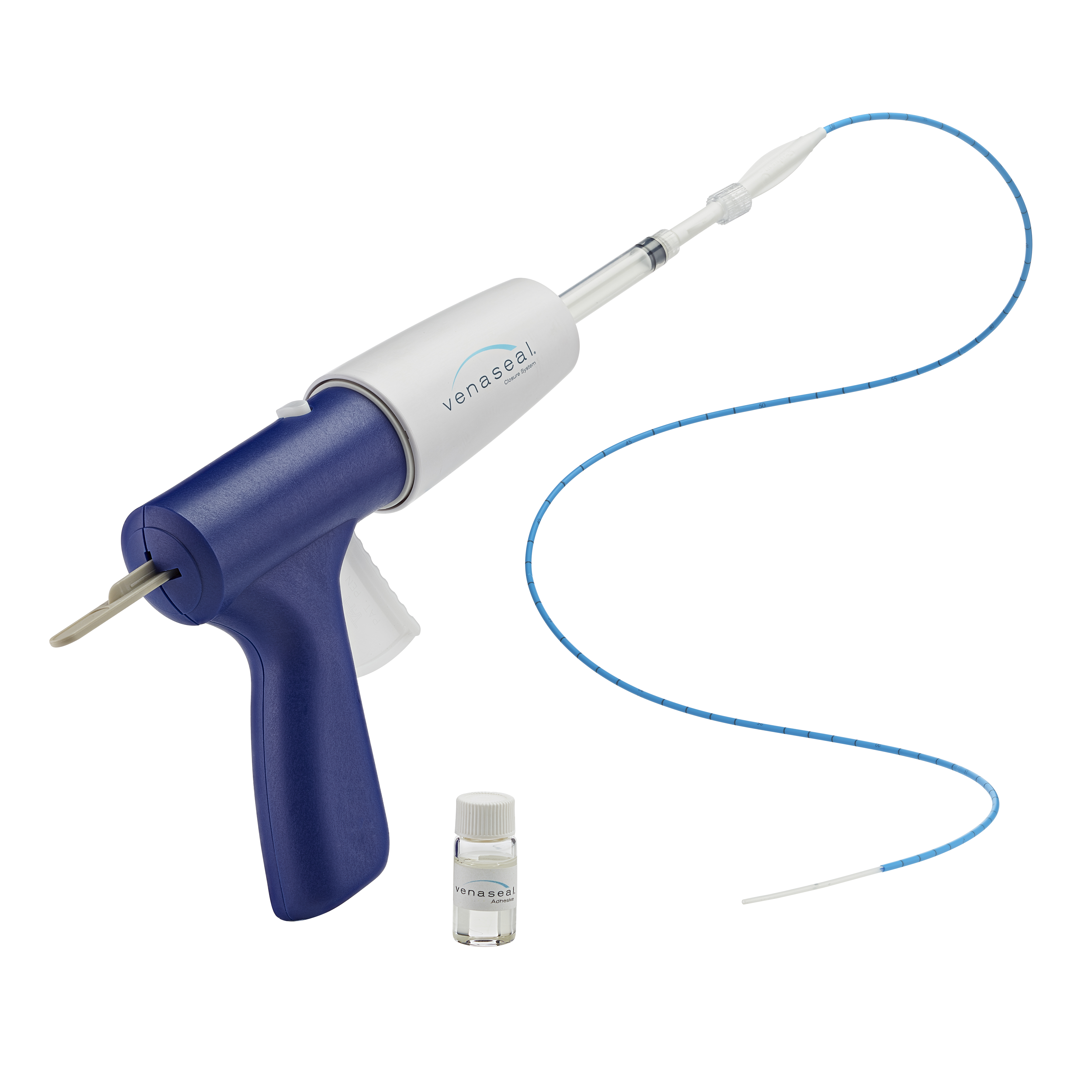New randomized controlled data from VenaSeal Spectrum Program reinforces evidence that VenaSeal™ closure system is safe and effective

Medtronic, the global leader in healthcare technology, today announced the VenaSeal Spectrum Program primary endpoints and 30-day modified Aberdeen Varicose Vein Questionnaire (AVVQ) results on the use of the VenaSeal™ closure system compared to surgical stripping (SS) and endothermal ablation (ETA) for the treatment of superficial venous disease. The results, which were presented today at Charing Cross International Symposium as a podium first presentation, also include safety and anatomic closure data through six months.
“The initial results of two of the three studies in the VenaSeal Spectrum Program reinforce the safety and effectiveness of the VenaSeal system as compared to current standards of care,” said John Laird, M.D., chief medical officer for the Peripheral Vascular Health business in the Medtronic Cardiovascular portfolio. “As one of the largest clinical programs in the venous space, the Spectrum Program demonstrates the Medtronic commitment to bring forward data to inform treatment decisions and advance the field of patient-centered research.”
The VenaSeal Spectrum Program is one of the largest and most innovative clinical programs in the treatment of venous disease. The program includes two randomized controlled clinical trials (RCTs) investigating the VenaSeal system versus SS and ETA and a single-arm study focused on venous leg ulcers. Two of the primary endpoints of the RCTs are measured using the Venous Treatment Satisfaction Questionnaire (VenousTSQ), a novel tool that measures patient satisfaction with the treatment received for superficial venous disease. Another primary endpoint of the study is the elimination of truncal reflux, which represents the percentage of diseased vein treated.
“The 30-day and six-month outcomes for both the surgical stripping and ETA studies are an important addition to the global clinical evidence for the VenaSeal system,” said Prof. Manj Gohel, M.D., primary investigator of the VenaSeal Spectrum Program and consultant vascular surgeon and honorary senior lecturer, Cambridge University Hospitals, Imperial College (Cambridge, U.K.). “This new, multi-center, randomized evidence about the minimally invasive VenaSeal system will provide the clinical community with key data to inform treatment decisions for patients with superficial venous disease.”
The VenaSeal system demonstrated superior peri-procedural patient satisfaction compared with surgical stripping, one of the primary endpoints in the RCTs. The other primary endpoint outcomes were not met. AVVQ results, a conventional endpoint, were trending in favor of the VenaSeal system at 30 days. Anatomic closure rate through six months was found to be comparable with the current standards of care for both studies. While the VenaSeal system was not able to demonstrate superiority across all endpoints, this minimally invasive procedure performed comparably to the current standards of care.
VenaSeal system vs. SS RCT (30-day outcomes)
- VenousTSQ peri-procedural: The primary endpoint was met, demonstrating superior patient satisfaction for the VenaSeal system peri-procedurally (p=0.0013, alpha=0.025)
- VenousTSQ post-procedural (30 days): The primary endpoint was not met; participants were similarly satisfied post-procedurally (p=0.0504, alpha=0.05)
- Elimination of Truncal Reflux*: The primary endpoint was not powered for testing due to early study closure; VenaSeal system performed similarly as SS (p=n/a, alpha=n/a)
- Modified AVVQ: The secondary endpoint was trending in favor of the VenaSeal system at 30-days (p=0.0039, alpha=n/a)
VenaSeal system vs. ETA RCT (30-day outcomes)
- VenousTSQ peri-procedural: The primary endpoint was not met; participants were similarly satisfied peri-procedurally (p=0.0260, alpha=0.0167)
- VenousTSQ post-procedural (30 days): The primary endpoint was not met; participants were similarly satisfied post-procedurally (p=0.7954, alpha=0.05)
- Elimination of Truncal Reflux*: The primary endpoint was not met; VenaSeal system performed similarly as ETA (p=0.0858, alpha=0.025)
- Modified AVVQ: The secondary endpoint was trending in favor of the VenaSeal system at 30-days (p=0.0076, alpha=n/a)
In addition, six-month data from both studies reinforce that the VenaSeal system has a safety profile consistent with peer-reviewed reports from other clinical studies1 showing low incidence of serious adverse events and VenaSeal system-specific complications occurring at low rates, all within the ranges found in peer-reviewed literature.
Anatomic closure through six months in the VenaSeal system treated population was non-inferior to surgical stripping (97.9% vs 92.9%; P-value = 0.00041). Anatomic closure was not formally tested (to control for multiple hypothesis testing) in the VenaSeal system vs ETA study, but similar effectiveness in each arm was observed (93.1% vs 93.6%, respectively).
“The Spectrum Program is expanding the way we look at the treatment of superficial venous disease by testing novel patient-centric endpoints,” said Dr. Kathleen Gibson, M.D., primary investigator of the VenaSeal Spectrum Program and vascular surgeon, Lake Washington Vascular Surgeons (Bellevue, Wash., U.S.). “To gather the most robust data possible from this study, the primary endpoints are joined by a comprehensive set of secondary endpoints using traditional measurements, which we look forward to sharing in the future.”
The Spectrum Program will follow up with patients over multiple years for select endpoints, expanding the body of long-term evidence for the VenaSeal system. Additional data will be released as it becomes available. More information on the VenaSeal Spectrum Program is available at medtronic.com/spectrum.
The VenaSeal closure system is commercially available in 70 countries including the U.S. and all EU member countries.
*Elimination of truncal reflux measurement: actual treatment length ÷ length of diseased vein = % of treated vein
1. Athavale A, Thao M, Sassaki VS, Lewis M, Chandra V, Fukaya E. Cyanoacrylate glue reactions: A systematic review, cases, and proposed mechanisms. J Vasc Surg Venous Lymphat Disord. 2023;11(4):876-888.e1.
Contacts:
| Erin Burns | Laura Hennen | Ryan Weispfenning |
| Public Relations | Public Relations | Investor Relations |
| +1-612-827-8952 | +1-763-213-3034 | +1-763-505-4626 |
About Medtronic
Bold thinking. Bolder actions. We are Medtronic. Medtronic plc, headquartered in Dublin, Ireland, is the leading global healthcare technology company that boldly attacks the most challenging health problems facing humanity by searching out and finding solutions. Our Mission — to alleviate pain, restore health, and extend life — unites a global team of 95,000+ passionate people across more than 150 countries. Our technologies and therapies treat 70 health conditions and include cardiac devices, surgical robotics, insulin pumps, surgical tools, patient monitoring systems, and more. Powered by our diverse knowledge, insatiable curiosity, and desire to help all those who need it, we deliver innovative technologies that transform the lives of two people every second, every hour, every day. Expect more from us as we empower insight-driven care, experiences that put people first, and better outcomes for our world. In everything we do, we are engineering the extraordinary. For more information on Medtronic (NYSE:MDT), visit www.Medtronic.com and follow @Medtronic on Twitter and LinkedIn.
Any forward-looking statements are subject to risks and uncertainties such as those described in Medtronic's periodic reports on file with the U.S. Securities and Exchange Commission. Actual results may differ materially from anticipated results.
